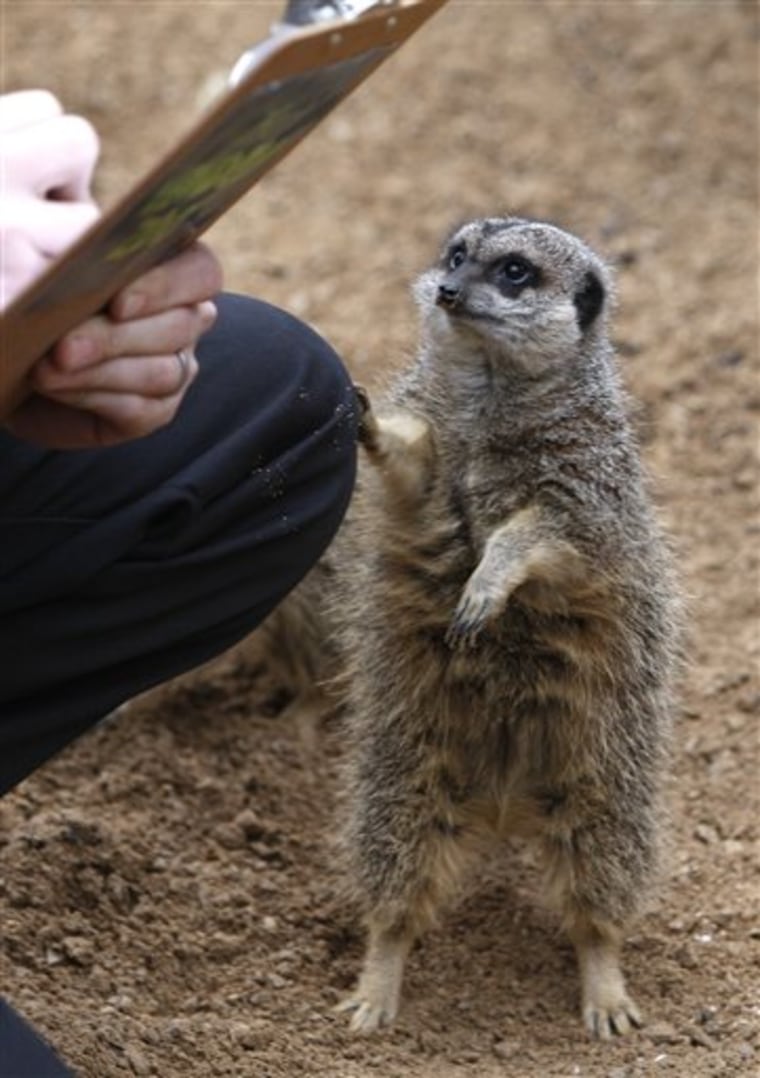How do you count scorpions?
Very gingerly, it turns out.
"You use tongs and pick them up by the stinger," London Zoo senior keeper Tony Dobbs said. "You avoid the pincers at all costs. You could get a nasty nick if you're not counting carefully."
Thursday was counting day at the London Zoo, so Dobbs not only had to count scorpions (13) but also the zoo's meerkats, millipedes and many other animals.
The annual count is a legal requirement for all British zoos, and it's also a useful tool for monitoring animal conservation efforts. Zookeepers say it makes sense to have a census.
"We have to tell the zoo licensing authorities exactly how many animals we have," said zoological director David Field, standing next to the manmade otters' pond. "It's not just the number of animals, it's who we've got, because many of our animals are individually identifiable."
Counting some of the London Zoo's more than 650 species is easy. There's only one giraffe — hard to miss. But other tasks are not for the squeamish: who really wants to spend hours determining if the population of 612 cockroaches has grown since last year?
All the information collected from British zoos is sent to a global animal-monitoring database run by a nonprofit group, the International Species Information System, or ISIS.
This treasure trove of updated data about animals throughout the world is used by the London Zoo and hundreds of others trying to monitor the threat to various species.
"This information forms the essential scientific foundation for the management of our conservation breeding programs," said Field.
The tally is particularly important when dealing with species that have become extinct in the wild.
Miranda Stevenson, director of the British and Irish Association of Zoos and Aquariums, said the information can be used to help develop breeding programs for species like the Socorro doves, which are no longer found in the wild.
"When zoos submit data to these central databases, it means that we can run detailed and scientifically based breeding programs to safeguard these valuable and threatened species," she said.
Some of the counts are a snap. Dobbs had no trouble tallying three meerkats in a spacious enclosure Thursday, although they did seem nervous when he walked in carrying a clipboard. They hid in tunnels and behind bushes until they saw the scraps of food he was carrying. After 10 minutes, they were practically sitting in his lap.
"Once they realized there was no threat, they were fine," said Dobbs.
But other species offer a formidable challenge.
Piranhas, for example, are very difficult to count, not just because of their strong jaws and impressive teeth, but because of their speed in the water.
"They can be quite tricky because they move around the tank very fast," said Dobbs. "It can be a nightmare to count 20 fish. But to be honest, they're not as dangerous as people think, as long as they're well fed."
He said keepers are cautious, nonetheless, about getting too close to the Amazon fish during the counting process. "We tend to avoid putting too much flesh into the tank, just in case."
They count each of the fregate beetles and rare partula snails one by one, but with some species, zookeepers have to compromise.
No one is required to count each and every leafcutter ant, for example — an estimate based on the exact number of ant colonies will just have to do, Field said.
He is particularly proud of two new additions to this year's census: Harry, the first warthog born at the London Zoo in roughly a century, and Conchita, an extremely rare white-naped mangabey monkey born in April by Caesarean section.
The survival of her species is very much in doubt because of the threat to its habitat in West Africa, making Conchita even more important, Field said.
"She's so endangered we needed to hand-rear her," he said. "She's now been integrated back into the group. That's a tremendous success."
More on Zoos | Threatened species
